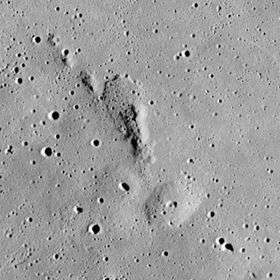Mons Esam
| Mons Esam | |
|---|---|
 Apollo 17 Mapping Camera Image, with Mons Esam at center, Diana below center, and Grace below right of center | |
| Highest point | |
| Listing | Lunar mountains |
| Coordinates | 14°36′N 35°42′E / 14.6°N 35.7°E |
| Geography | |
| Location | the Moon |
Mons Esam is a small, isolated mountain in the northern part of the Mare Tranquillitatis. It is located to the southeast of the crater Vitruvius, and to the west-northwest of Lyell. To the northeast of this ridge is the bay called Sinus Amoris.
The selenographic coordinate of this feature is 14.6° N, 35.7° E, and it has a maximum diameter at the base of 8 km. The name of this feature is an Arabic masculine name (عصام), and it was not chosen to represent a specific individual. This peak is a lunar cone that was formed through tectonic processes.
A pair of tiny craters just to the south of Mons Esam have been assigned names by the IAU. These are listed in the table below. The craters are at the tops of two lunar domes, which are most likely volcanoes and were not formed by impacts.
| Crater | Latitude | Longitude | Diameter | Name source |
|---|---|---|---|---|
| Diana | 14.3° N | 35.7° E | 2 km | Latin feminine name |
| Grace | 14.2° N | 35.9° E | 1 km | English feminine name |
References
- Weitz, Catherine M.; Head III, James W. (1999). "Spectral properties of the Marius Hills volcanic complex and implications for the formation of lunar domes and cones". Journal of Geophysical Research. 104: 18,933–18,956. Bibcode:1999JGR...10418933W. doi:10.1029/1998JE000630. Retrieved 2007-08-06.
- Andersson, L. E.; Whitaker, E. A. (1982). NASA Catalogue of Lunar Nomenclature. NASA RP-1097.
- Blue, Jennifer (July 25, 2007). "Gazetteer of Planetary Nomenclature". USGS. Retrieved 2007-08-05.
- Bussey, B.; Spudis, P. (2004). The Clementine Atlas of the Moon. New York: Cambridge University Press. ISBN 978-0-521-81528-4.
- Cocks, Elijah E.; Cocks, Josiah C. (1995). Who's Who on the Moon: A Biographical Dictionary of Lunar Nomenclature. Tudor Publishers. ISBN 978-0-936389-27-1.
- McDowell, Jonathan (July 15, 2007). "Lunar Nomenclature". Jonathan's Space Report. Retrieved 2007-10-24.
- Menzel, D. H.; Minnaert, M.; Levin, B.; Dollfus, A.; Bell, B. (1971). "Report on Lunar Nomenclature by the Working Group of Commission 17 of the IAU". Space Science Reviews. 12 (2): 136–186. Bibcode:1971SSRv...12..136M. doi:10.1007/BF00171763.
- Moore, Patrick (2001). On the Moon. Sterling Publishing Co. ISBN 978-0-304-35469-6.
- Price, Fred W. (1988). The Moon Observer's Handbook. Cambridge University Press. ISBN 978-0-521-33500-3.
- Rükl, Antonín (1990). Atlas of the Moon. Kalmbach Books. ISBN 978-0-913135-17-4.
- Webb, Rev. T. W. (1962). Celestial Objects for Common Telescopes (6th ed.). Dover. ISBN 978-0-486-20917-3.
- Whitaker, Ewen A. (1999). Mapping and Naming the Moon. Cambridge University Press. ISBN 978-0-521-62248-6.
- Wlasuk, Peter T. (2000). Observing the Moon. Springer. ISBN 978-1-85233-193-1.